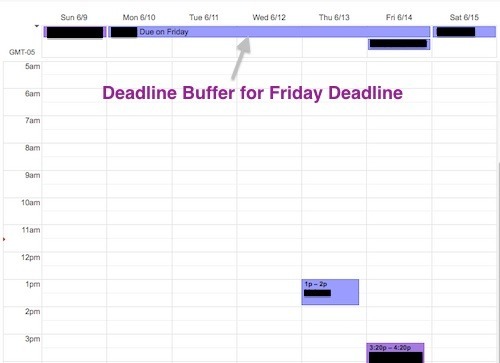Controlling Your Schedule with Deadline Buffers

A Hard Week
Last week was hard. Four large deadlines landed within a four day period. The result was a week (and weekend) where I was forced to violate my fixed-schedule productivity boundaries.
I get upset when I violate these boundaries, so, as I do, I conducted a post-mortem on my schedule to find out what happened.
The high-level explanation was clear: bad luck. I originally had two big deadlines on my calendar, each separated by a week. But then two unfortunate things happened in rapid succession:
One of my two big deadlines was shifted to coincide with the second big deadline. Because I was working with collaborators, I couldn’t just ignore the shift. The new deadline would become the real deadline.
The other issue was due to shadow commitments – work obligations you accept before you know the specific dates the work will be due. I had made two such commitments months earlier. Not long ago, however, their due dates were announced, and they both fell square within this brutal week.
The easy conclusion from this post-mortem is that sometimes you have a hard week. Make sure you recharge afterward and then move on.
This is a valid conclusion And I took it to heart. But it’s not complete…
The Deadline Banner
As I dug deeper through the forensic detritus of this brutal week I noticed that I could have made it less brutal. As deadlines popped up or shifted on my schedule, I dutifully updated them on my calendar. But in doing so, I didn’t appreciate the monumental work pile-up these shifts were creating. If I had noticed this, I could have invoked some emergency measures earlier to lessen the load.
In response to this revelation I am now toying with a simple tweak to how I use my calendar: the deadline buffer.
The idea is simple…
Any serious deadline should not exist on your calendar just as a note on a single day. It should instead by an event that spans the entire week preceding the actual deadline. (In Google Calendar, I do this by making it an “all day” event that lasts the full duration; e.g., as in the screenshot at the top of this post.)
The motivation behind this hack is to eliminate the possibility for pile-ups to happen without your knowledge. If you buffer each deadline with a week-long event, any overlap will become immediately apparent.
As a bonus, this approach also helps you keep these key pre-deadline weeks clear of excessive meetings. It’s easy, for example, to agree to a non-urgent interview months in the future. But when you see that this date has a deadline buffer in place, you become more likely to say, “actually, let’s schedule this for the week after…that week is going to be a little tight.”
This is the type of prescient scheduling you’ll appreciate when the deadline looms and you see before you a delightfully light schedule.
In the spirit of anti-planning, I don’t know how well this will work, but it’s worth some experimentation.


Cal Newport's Blog
- Cal Newport's profile
- 9946 followers



